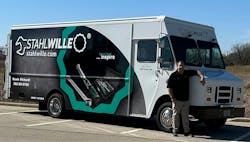When Kevin Richardt, an independent tool dealer in Milwaukee, Wisconsin, working in partnership with Stahlwille, was in the market for a tool truck, he knew he wanted something reliable. Not wanting to go into major debt, Richardt bought a basic, bare-bones Morgan Olson-style truck from Herr Display Vans and crafted it to fit his needs.
At the time, the truck wasn’t exactly what he’d envisioned. It didn’t have shore power A/C and other features he’d been looking for, but it was the right decision for his circumstances, and it came at a price he couldn’t pass up. Now, four years later, Richardt looks back on his choice and couldn’t be happier with his decision.
A simple truck, one that doesn’t take much effort to maintain and keep on the road, has saved him both money and countless headaches. He jokes that he drives a covered wagon because at the end of the day, his truck is merely a vessel to deliver products.
“I just didn’t subscribe to the norm of having a truck to make some kind of statement,” says Richardt. “I didn’t believe I needed that to be a successful tool dealer.”
Endless possibilities
Perhaps an obvious benefit to buying a more basic truck is the seemingly endless possibilities for customization. An empty truck void of “bells and whistles,” as Richardt puts it, is a blank canvas to work on.
At the entrance to the truck, the commercial carpet Richardt installed catches the debris from technicians’ feet as they enter. LED floodlights above the liftgate in the rear of the truck allow Richardt to see clearly at night when loading or unloading products. Across the truck, subtle details like these solve common problems a distributor might encounter when working.
Instead of keeping his counter cluttered with inventory, Richardt upgraded to a wireless barcode scanner so he can walk around the truck and scan whatever item he needs. Also at the counter, Richardt uses a high-powered gaming laptop mounted on a shock-absorbing stand that he can move out of the way to create even more workspace.
Richardt’s workspace has seen some of the most upgrades since he bought the truck in August 2020. In addition to the laptop, Richardt upgraded from a mouse to a trackball that he finds much faster, and its stationary nature ensures it won’t get lost in the shuffle of the workday.
Prioritizing the everday items
In his truck, Richardt has prioritized everyday tools instead of big-ticket items. The distributor has come to understand that if you can’t sell the basics, then you most likely won’t make it far in this industry. Instead of dedicating a large portion of his truck to bigger tool storage products, he had Herr build out a toolbox pocket on the truck so he can still offer storage carts or roll carts as needed.
“That made a big difference,” Richardt says. “Now I can have floor-to-ceiling products … and still have an opening for tool storage, carts, and roll carts. It didn’t make sense to have two wide open pockets when I’m not going to be moving that kind of tool storage.”
Everything has its place
When organizing his truck, Richardt tries to keep everything together based on the product’s category. All suspension service products stay together, all diagnostic, all tire service, and so on. Within those categories, he tries to group tools by their brand. This system has worked well for his customers, and they’re easily able to find what they’re looking for. As for new products, those get a special place front and center, or they go to the large shelf over the toolbox pocket with other sale products. Rotating the placement of these products, Richardt finds, allows his full inventory to get a chance in the spotlight.
“With limited space on a tool truck, it can be difficult,” says Richardt. “It’s like putting a puzzle together. Customers like to comment on how things are organized, clean, and look good.”
About the Author
Elli Carder
Assistant Editor | PTEN & Professional Distributor
Elli Carder is an assistant editor for Endeavor Business Media's Vehicle Repair Group. With a background in professional and creative writing, Carder helps edit for both Professional Tools and Equipment News (PTEN) and Professional Distributor magazines, as well as VehicleServicePros.com.
Don't miss Carder's next article. Sign up for PTEN or Professional Distributor's weekly newsletter.

